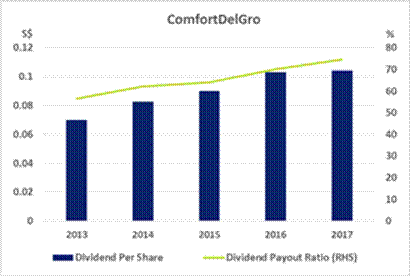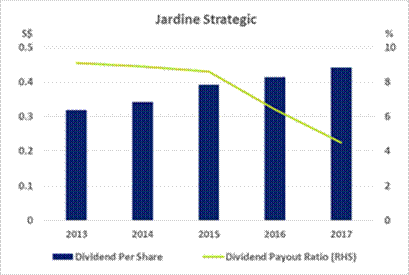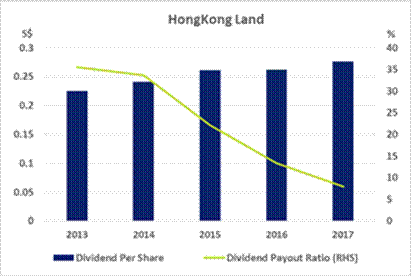Five STI Stocks Consistently Increased Dividends Over 5 years
Five STI stocks that have consistently increased its dividends over the past 5 years are SATS, ComfortDelGro, Jardine Matheson, Jardine Strategic and HongKong Land. These five stocks make up almost 15% of the STI weight & averaged a dividend yield of 3.0% in 2017.
While the dividend yields of the Jardines and HongKong Land are lower than the STI’s yield of 3.1% in 2017, the trio’s average dividend per share has gradually increased at a CAGR of 5% over the past 5 years, in line with the STI.
A company may increase its dividend for various reasons. Ideally the increase is a result of an increase in the company’s net profit. However it could also be the case that the company is rewarding shareholders on windfall returns or distributing disposal proceeds.
mongst the 30 Straits Times Index (‘STI’) constituents excluding the three Real Estate Investment Trusts (‘REITs’), five companies have consistently distributed higher dividends per share over the past 5 years. The absolute dividend per share distributed is used rather than dividend yield as the latter is affected by stock price movement.
Dividends represent a way for the relevant company or trust to distribute some of its profits back to its investors. Income received from dividend distributions can be an important part, if not a primary objective of investing. The aforementioned five companies have consistently distributed higher dividends per share over the past 5 years make up as much as 14.4% of the STI weights based on 30 March 2018 prices.
Five STI Stocks that have consistently increased dividends over the last 5 financial years
1. SATS
Provides gateway services and food solutions in Singapore, Japan, and internationally.
Declared a final dividend of 18 cents per share for FY2018 ended March 31, 2018 compared to 17 cents per share paid in FY2017.
Reported profit attributable to owners of the company of SGD 261.5 million for FY2018 against SGD 257.9 million for FY2017
Dividend Yield (FY2018): 3.5%
2. ComfortDelGro
A land transportation company that offers public and charter bus services, public taxi services, car rental and leasing services.
Paid out a final dividend of 10.4 cents per share for the year ended December 31, 2017.
Reported profit attributable to shareholders decreased by 4.9% to $301.5 million in FY2017.
ComfortDelGro owns 74.6% of SBS Transit, a company outside of the STI that has also been steadily growing its dividends.
Dividend Yield (FY2017): 5.3%
3. Jardine Matheson
A conglomerate that engages in motor vehicles, property investment and development, food retailing, home furnishings, engineering construction, and transportation businesses.
Paid out total dividends of 160 US cents per share for 2017, an increase by 7% from FY2016
Profit attributable to shareholders of the company was $3,785 million in FY2017 compared with $2,503 million in FY2016.
Dividend Yield (FY2017): 2.6%
4. Jardine Strategic
As a subsidiary of Jardine Matheson, the company operates in similar business segments as the latter.
Paid out total dividends of 32 US cents per share for 2017, up 7% from FY2016.
Profit after tax attributable to shareholders of the company was $4,119 million in FY2017 compared to $2,741 million in FY2016.
Dividend Yield (FY2017): 0.8%
5. HongKong Land
A subsidiary of Jardine Strategic, the company engages in the investment, development, and management of real estate in Greater China, Southeast Asia and internationally.
Paid out dividends of 20 US cents per share for FY2017, up 5% from FY2016.
Profit attributable to shareholders was USD 5,585 million in FY2017 compared to USD 3,346 million in FY2018.
Dividend Yield (FY2017): 2.8%
Financial information and chart data Sourced from StockFacts and Bloomberg
Some factors to consider
What is the reason being the dividend increases?
A company may choose to reinvest less and instead pay out dividends for a variety of reasons. For example, the company might wish to consolidate and reassess its market position before committing further funds for expansion or the company might choose to postpone major capital expenditures due unfavourable financing rates or the company might increase its dividend payout to attract further equity investments. It could also be the case that the company is rewarding shareholders on windfall returns or distributing disposal proceeds.
How much is the dividend growing by?
Another consideration when it comes to dividend growth stocks is how much the dividend is growing. Measuring the growth in final dividend per share from year to year would be a rough gauge on how much the dividend has grown. Over a longer period, the CAGR formula can be used instead. The 5 STI stocks above averaged a CAGR of 6% over the past 5 years, as compared to the STI’s CAGR of 5% over the same period.
Can the company sustain its dividends?
The dividend payout ratio is a common metric used to evaluate company’s ability to sustain its dividends or dividend growth. The dividend payout ratio shows the percentage of a company’s earnings being paid to shareholders as dividends. A dividend payout ratio that consistently exceeds 100% is definitely not sustainable. A stable dividend payout ratio below 100% over time is considered favorable as it shows that earnings are sufficient to support the dividend payouts for investors.
This article was originally published on SGX.

 Yahoo Finance
Yahoo Finance 





